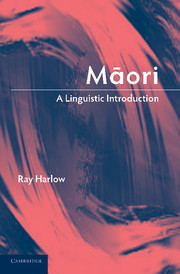Book contents
- Frontmatter
- Contents
- List of figures
- List of maps
- List of tables
- Acknowledgements
- List of abbreviations
- Introduction
- 1 Māori literature and literature on Māori
- 2 A brief history of Māori
- 3 Regional variation in Māori
- 4 The phonology of Māori
- 5 The morphology of Māori
- 6 The syntax of Māori
- 7 The sociolinguistic situation of Māori
- References
- Index
7 - The sociolinguistic situation of Māori
Published online by Cambridge University Press: 28 January 2010
- Frontmatter
- Contents
- List of figures
- List of maps
- List of tables
- Acknowledgements
- List of abbreviations
- Introduction
- 1 Māori literature and literature on Māori
- 2 A brief history of Māori
- 3 Regional variation in Māori
- 4 The phonology of Māori
- 5 The morphology of Māori
- 6 The syntax of Māori
- 7 The sociolinguistic situation of Māori
- References
- Index
Summary
Until the final decades of the eighteenth century, Māori was the only language spoken in New Zealand. There is no evidence of any substrate influence on the Eastern Polynesian language(s) brought to New Zealand some 800–1,000 years ago. Neither had the brief visit of Abel Tasman in 1642 any impact whatsoever on the language. However, after James Cook's voyages in 1769–74, contacts with the outside world began which would in time have near-fatal consequences for the Māori population, culture and language. Chapter 2 sketches some of the consequences of the contact with English for the shape of the language; this chapter will concentrate on the development of the symbiosis of Māori and English and its consequences for the demography of knowledge of the language, the status of the language, policy, education, language maintenance, attitudes to the language, and related areas. On all aspects of these topics there is considerable and widespread literature so that the goal of this chapter will be to provide an overview with relevant references, but at the same time to present something of the personal perspective of the writer, who has been involved in a variety of roles in some of these areas over the last twenty years or so. Some of the following material is thus necessarily more anecdotal in character than the result of formal research.
Language Shift
Demography
King (2003:90–1) estimates the population of New Zealand in the eighteenth century at 100,000 to 110,000.
- Type
- Chapter
- Information
- MaoriA Linguistic Introduction, pp. 192 - 223Publisher: Cambridge University PressPrint publication year: 2007



